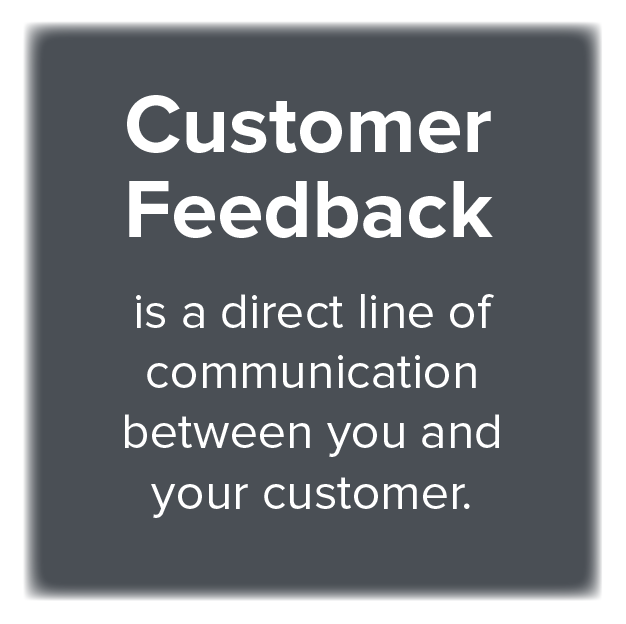“We love the feedback from customers - good, bad or indifferent. It's a great tool. Service has been spot on when needed!"
Customer Feedback
What's your business process to gather customer feedback so you can listen, learn and improve?

What is Customer Feedback?
Customer Feedback is a direct line of communication between you and your customer. It’s the only true way to know and understand how your customer feels about their interaction with your business. While you assume and hope that they are having a great customer experience, chances are improvements can be made to every customer interaction.
Your customers are your business. They are the reason you go to work every day and you would do anything to keep them happy. But how can you be sure that all the work you are putting in is creating a better experience for your customer?
How can you be sure exactly what your customer wants? One answer – ask them!
Why is Customer Feedback Important?
The best way to improve your business is to listen – carefully and honestly – to what your customers say about your business.
It may not be fun to hear, but listening to negative customer feedback is critically important to improving the customer experience, and thereby increasing customer loyalty. Yes, some customer complaints are completely over-the-top and nothing you can do would appease that customer. However, most negative customer feedback centers around real problems that exist in your business, of which you may or may not be aware.
Your customers interface with your business every day – they know the exact pain points and imperfections of interacting with, and completing a transaction with, your business. Thoughtfully listen to what they have to say, be open to receiving their feedback (positive or negative) and make adjustments to your business. Listening to customer feedback won’t automatically make your company perfect (because no company is perfect), but it will set you on a path of providing exceptional customer experiences, which is the real goal of any business..
How Do You Gather Customer Feedback?
Let’s face it - we are inundated with surveys. Chances to win gift cards that will never materialize, false promises of ‘quick’ surveys, and unacknowledged poor experiences all lead to a general frustration with surveys as a whole. They are typically too long and inconveniently navigate away from whichever email or webpage they originate from.
However, surveys really are the most efficient way to receive feedback from customers. Many transactions occur online, limiting the opportunity to collect in-person feedback. And even if you do collect feedback in-person, are you capturing it in systematic way that allows your company to use it? Plus, some customers may not want to express their full opinions in-person for fear of a confrontation. Email-based surveys allow customers to express themselves openly, and are a direct communication about their experience with your business and brand. Therefore, you should be using them to gather feedback from your customers.
If you’re going to use surveys (and you should), do it right. Asking for feedback is one aspect, and acting on it is an even bigger one. If you genuinely want to know what your customers are thinking or feeling about your brand, and are committed to creating a long-lasting relationship with your customer to keep them in the customer loyalty loop, follow these guidelines: keep it short, make it easily accessible, know what you’re trying to measure, and (most importantly) follow up.

What Are the Types of Customer Feedback?
Customer feedback comes in many forms, but there are 3 basic types of feedback to consider.
Customer Satisfaction (CSAT) is your customer’s attitude toward the product or service they bought from you. If you’re thinking, ‘I provide great service, so all my customers must be satisfied!’ then think again. Just providing good customer service isn’t enough. Measuring CSAT is like a snapshot of how a customer feels at a given time. CSAT is measured with survey questions in the form of open-ended questions, multiple choice questions, questions with a range from ‘Very Dissatisfied’ to ‘Very Satisfied,’ Yes/No questions, among others.
Customer Effort Score (CES) is a measure of the level of difficulty your customer experiences when interacting with your company. It can refer to the ease with which they were able to complete their purchase, how easily they found resources they were looking for, or how quickly they were able to answer questions they had.

Customer Loyalty Survey or Net Promoter ScoreSM (NPS®) Survey is a snapshot of how your customers feel about you at any given time, measured throughout the customer's journey with your business. Customer loyalty is your customer’s ongoing behavior to continue purchasing from you. Measuring customer loyalty is more of a long term look at the value of your customers, using the NPS (Net Promoter Score) metric. It is related to CSAT, but different. Typically, satisfied customers are more likely to be loyal, but just because they had a good experience once doesn’t mean they are magically going to buy from you from now on. NPS is a simple metric that allows you to gauge your customer’s sentiment toward your business. It is calculated by asking one question: How likely is it that you would recommend our company to friends and colleagues? The customer is presented with a scale from negative sentiment to positive, and depending on their answer are categorized as either a Promoter, Passive or Detractor.
With all types of customer feedback, the surveys should collect open-ended comments from the customer. This allows the customer to freely express their feelings and experiences, allowing you to listen, learn and take action. When you receive negative feedback, you can immediately reach out that customer and hopefully remedy the situation. 67% of customer churn is preventable if the issue is resolved during the first interaction. On the other hand, positive individual feedback can be converted into customer testimonials and reviews to further amplify positive experiences on your website, social media, and marketing materials. These testimonials and reviews can attract new business and also confirm other customer’s experiences, making them want to continue buying from you.
How Often Should You Get Customer Feedback?
Depending on your business, you can be gathering feedback from customers as often as after every transaction. However, it varies based on your industry and your relationship with your customers.
The biggest hurdle to asking customers to provide feedback is your time commitment. It takes time to ask, record, and analyze results. Do not – do not – waste your customer’s time asking for feedback if you are not going to devote the time to dig in to the results and look seriously at what they are saying.
Fortunately, processes exist that automate gathering customer feedback. With LoyaltyLoop’s customer review software, you can easily and automatically flow customers to-be surveyed into LoyaltyLoop, automatically ask for customer feedback via email, record the results, and analyze – all in one dashboard. You can tune in to specific issues and remedy individual customer complaints; and you can look at the overall customer sentiment using Net Promoter Score (NPS), tracking your progress over time.
It’s not practical to personally ask every person for feedback after every transaction. Leverage an automated process of soliciting customer feedback to ensure that every customer has the opportunity to give feedback, and their input gets recorded and heard.
What You Should Do with Customer Feedback
Thank your customers for their feedback, regardless if it’s positive or negative. Reinforce positive experiences with incentives and respond to negative feedback quickly to create a positive remembered experience and increase your chances of capturing repeat business.
Now that you’ve listened to your customers and are armed with their feedback, you need to turn their feedback into actions. Delivering outstanding customer experiences is a continual process of gathering feedback and making adjustments. Nothing in business is static – we must continually evolve and adapt based on our customer’s needs.
Develop a culture where customers are heard (the good, the bad, and the ugly), their feedback is analyzed, and improvements are made. Use newsletters and other marketing to communicate with customers when their input has been implemented, so they (and other customers) see that you're listening and responding to real customer issues. Through these customer-inspired continuous improvements, more customers will remain in the loop and you’ll be delivering greater numbers of outstanding customer experiences, increasing customer loyalty.
